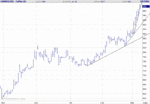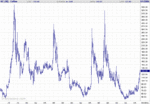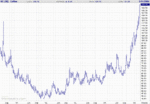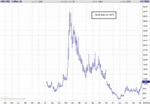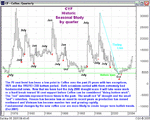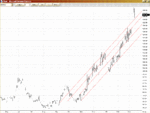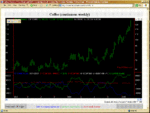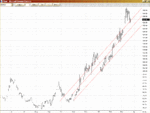Bloomberg :
Coffee rises to 5-year high in LONDON on Vietnam Drought.
Brazil Annual Inflation Rate Slows a Second Month on Higher Interest Rates
ABN Amro Recommends Buying Brazil Real; Forecasts 2.5 Per Dollar in May
Coffee Reaches Five-Year High in London; Lack of Rain May Cut Vietnam Crop
Coffee Rises to Five-Year High in London on Vietnam Drought
March 11 (Bloomberg) -- Robusta coffee futures rose to a five-year high in London after gaining in Tokyo on concern a lack of rainfall will damage crops in Vietnam, the biggest supplier of the bean variety.
Robusta, used by processors such as Nestle SA and Procter & Gamble Co. to make instant coffee, has surged 47 percent this year to the highest since February 2000 on Liffe. Vietnam's top coffee-producing province may have its driest year since 1978, a government agency said last week.
``Production is falling as Vietnam is facing drought,'' said Yutaka Hama, a commodities analyst at Okato Shoji Co. in Tokyo today. ``Concern about the situation is surfacing again.''
Robusta for delivery this month rose $42, or 4 percent, to $1,085 a metric ton on Liffe at 10:23 a.m. London time. The two- day gain of 10.8 percent is the biggest in almost three years. On the Tokyo Grain Exchange, Robusta for January delivery ended trading up 600 yen per 100 kilograms, or 5.4 percent, at 11,770 yen ($1,130 a ton).
Japan is the world's third-biggest coffee importer, supporting 90,000 coffee and tea shops that sell $9.9 billion of beverages a year. The country also is buys Arabica, the milder- tasting variety preferred by specialty roasters.
The coffee harvest in Brazil, the world's biggest Arabica grower and exporter, may fall as much as 24 percent, Singapore- based coffee supplier Olam International Ltd. said this week.
Roasters in Japan are seeking to bolster inventories on concern any frost in Brazil will erode production more and cause prices to rise further, Olam's Chief Executive Sunny Verghese said in a March 9 interview.
Inventory Buildup
``They're wanting to take longer inventory cover than in the past,'' he said. ``Those who were satisfied with a 12-month inventory cover are now wanting 18 months cover to make sure they don't get caught.''
Olam is one of the three largest exporters of bitter-tasting Robusta beans from Vietnam, where a lack of rain during the next two months ``could see a significantly lower crop next year,'' Verghese said. ``Production could come down from early estimates of between 950,000 and 1 million tons to 800,000 tons or lower.''
Vietnam accounts for about half of world's Robusta exports. In the main coffee-growing province of Dak Lak, crop losses from drought may total at least 100,000 tons, the Tuoi Tre newspaper reported today, citing local traders. That would leave about 220,000 tons, the report said.
``Soil moisture is reported as being below normal for this time of the year,'' in Vietnam, U.S.-based forecaster Meteorlogix said March 10. ``Rainfall will be needed to support the next coffee crop.''
Arabica futures in Tokyo also rose today. Arabica for delivery in January climbed 800 yen, or 3.5 percent, to close at 23,590 yen per bag ($1.49 a pound). They have surged 41 percent this year, outpacing Arabica's 33 percent jump on the New York Board of Trade.
To contact the reporter on this story:
Julie Tay in Tokyo at
jtay1@bloomberg.net
Jason Gale in Singapore
j.gale@bloomberg.net
To contact the editor responsible for this story:
Peter Langan at
plangan@bloomberg.net
Last Updated: March 11, 2005 05:32 EST


